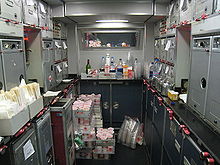Galley
With the Anglizismus Galley is called in German the galley of a transport aircraft . In English usage, galley generally refers to the kitchen in air , rail and water vehicles .
description
A galley differs from normal kitchens mainly in the very limited space available and in the special containers (boxes) and trolleys that are optimized for use during transport . In general, space is so limited that there are several things to watch out for when cooking on board. As a rule, the only built-in electrical appliances are the convection oven and the coffee machine , which is also a hot water boiler .
history

The first kitchens in aircraft can be found in large airships like the Zeppelin . Here, a multi-course meal was prepared for the passengers in the traditional way in electric cooking appliances, which was not possible in the first passenger aircraft due to the space required for a conventional kitchen at that time. A first known kitchen in an airplane consisted of a hotplate with a sink, which was built into a Junkers Ju 52 for a Romanian prince in 1930 on the advice of Werner Sell . Sell, who initially worked on concepts for fitted kitchens , was commissioned by Lufthansa employees in 1954 to develop a kitchen for the aircraft on Lufthansa's new Atlantic routes. The previously known aircraft kitchens manufactured in the USA were unsuitable for the purposes of Lufthansa. Thanks to convincing concepts and ideas for the planned aircraft kitchen, Sell was soon able to develop into one of the leading manufacturers of aircraft kitchens, which are still installed in a large number of aircraft today.
Today's use
Aircraft kitchens are optimized for the preparation of food in the smallest of spaces, so that conventional kitchen equipment and materials are hardly used in aircraft kitchens. Usually the prepared dishes are not cooked on site, only ready-made meals are warmed up; there are very few airlines that actually cook. But not only the space requirement is decisive for not having an extensive facility, safety regulations would also prohibit the preparation of a full meal.
The aircraft food , prepared, portioned and often delivered frozen by catering services, is warmed up in steamers or microwave ovens and served to the passengers. The preparation of the meals served on the plane begins up to 72 hours before the machine starts. The supply of food is one of the most important logistical tasks in passenger air traffic. Airline specifications, passenger numbers and special orders must be coordinated. In addition, along with the food, the duty-free items are also brought on board the aircraft by caterers.
The kitchen technology required in the aircraft is reduced to the cooling unit and heating device, together usually called the kitchen cabinet ( pantry ). In most modern aircraft, the food is delivered directly via roll containers (trolleys) and containers. A Boeing 747-400, for example, is equipped with 114 containers, 102 trolleys and 18 ovens.
In newer aircraft, such as the Airbus A340-600, there is the option of installing coolable compartments. These work more effectively than the otherwise commonly used dry ice , which sublimates when heated and then no longer has a cooling effect.
Very important in airplanes is the ability to secure every removable container, every trolley and every door with toggles against falling out or opening. This is particularly important during take-off and landing as well as during turbulence .
Worldwide, airlines mainly use the standard norms ATLAS and KSSU developed by the ATLAS and KSSU consortium for galleys and trolleys, with ATLAS being used by around 80% and KSSU by around 20%. In 2008, the aircraft manufacturer Airbus presented another cabin concept for galleys called SPICE ( SPace Innovative Catering Equipment ).
As an exception, the kitchens of aircraft for business travelers can be seen. While the primary goal in normal commercial aircraft is to provide passengers with fast and effective care, the focus in aircraft that specializes in business travelers is on passenger comfort. The galley can be adapted to different needs, the possibilities of which are almost unlimited and which are only limited by the space available.
Since the galley is often used as a separation between passenger classes, the on- board toilet can also be installed flush .
| ATLAS | KSSU | |||||
|---|---|---|---|---|---|---|
| height | width | depth | height | width | depth | |
| trolley full size | 103 | 30.4 | 81 | 103 | 30.4 | 84.8 |
| trolley half-size | 103 | 30.4 | 40.5 | 103 | 30.4 | 42.4 |
| Standard unit half size | 27.8 | 29.4 | 40.9 | 31.5 | 29.5 | 42.5 |
| Standard unit full size | 42 | 29.4 | 40.9 | 47 | 29.5 | 42.5 |
| oven rack | 41.4 | 22.55 | 38.7 | 38 | 25.5 | 36.2 |
Web links
Individual evidence
- ^ Christoph Schäfer: Werner Sell . In: Magistrat der Stadt Wetzlar (Ed.) Tüftler & Talente. 150 years of technical innovations in Central Hesse . Wetzlar 2004
- ↑ On- board kitchen manufacturer: In an airplane, the slim line counts. In: fr-online.de . August 23, 2008, accessed December 20, 2014 .
- ↑ Lufthansa newslink, issue 38, July 2007, page 13 ( memento of December 30, 2013 in the Internet Archive ). Article at Germany Online.
